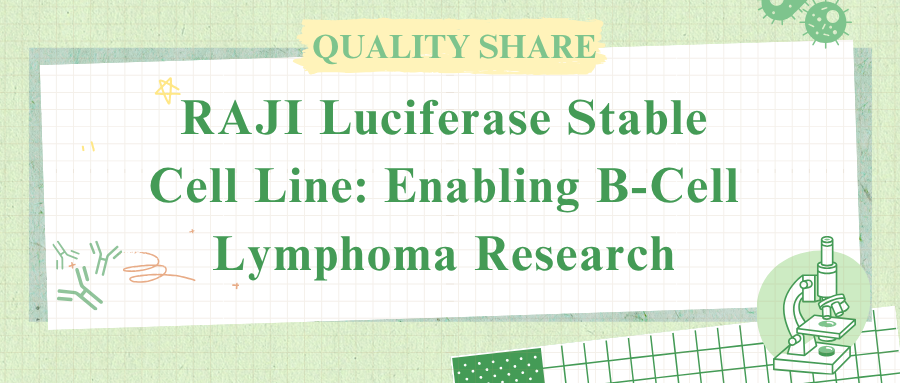
RAJI Luciferase (RAJI-Luc) stable cell line is a human Burkitt lymphoma cell line engineered to express the Firefly Luciferase reporter gene, derived from highly proliferative RAJI cells. Leveraging bioluminescence detection, RAJI-Luc cells enable real-time, non-invasive monitoring of tumor growth and metastasis, making them an ideal tool for studying B-cell lymphoma mechanisms, drug screening, and immunotherapy research. This article provides a detailed overview of the use of RAJI-Luc cells in lymphoma model construction and research applications, including experimental protocols and optimization strategies. Selecting EDITGENE’s in-stock RAJI-Luc cell line allows researchers to rapidly initiate studies and save time in model development.
Advantages of the RAJI-Luc Cell Line in Lymphoma Research
The RAJI-Luc cell line, featuring high proliferative capacity and stable bioluminescent signal, serves as an ideal tool for B-cell lymphoma studies and is suitable for the following applications:
- ● Metastasis Mechanism Studies: Models Burkitt lymphoma metastasis to bone marrow, liver, and lymph nodes, allowing real-time tracking of metastatic dynamics.
- ● Drug Screening: High-sensitivity luminescence supports high-throughput screening of chemotherapeutics, targeted drugs, or nanomedicines.
- ● Immunotherapy Research: Evaluates tumor immune microenvironment changes when combined with CAR-T or PD-1 inhibitors.
- ● Gene Function Validation: Enables gene knockout or overexpression (e.g., CRISPR-mediated MYC editing) to study the c-MYC pathway.
- ● In Vivo and In Vitro Models: Supports xenograft models in immunodeficient mice, with non-invasive IVIS imaging to reduce animal usage.
EDITGENE’s RAJI-Luc cell line is optimized for all the research applications above, with >99% purity and high activity. Bulk orders are available at discounted rates.
Luciferase Assay Results:
|
Sample
|
Replicate 1
|
Replicate 2
|
Replicate 3
|
Mean
|
Fold Expression
|
|
WT
|
1146
|
1542
|
2518
|
1735
|
15
|
|
LUC
|
27583
|
26441
|
25265
|
26430
|
Advantages:
- ● Purity >99%, activity >1.2×10^6 RLU/10^5 cells (n=3, SD <5%).
- ● Stable through >20 passages, metastasis efficiency >80% (validated by IVIS).
- ● Comes with COA and SOP; bulk orders are eligible for discounts.
Construction Method of RAJI-Luc Cell Line
Construction Principle
The RAJI-Luc cell line is established using genetic engineering techniques by inserting the luciferase gene (luc) into a vector and transfecting it into parental RAJI cells to achieve stable expression. Luciferase catalyzes the oxidation of its substrate luciferin, producing bioluminescence with a wavelength of approximately 550-570 nm. The light intensity correlates linearly with enzyme expression levels. Common configurations include a single luciferase system or a dual-luciferase system, where Renilla luciferase serves as an internal control to standardize experimental results.
Common Construction Method
The most widely used approach is lentiviral transfection, which allows efficient and stable genomic integration. The typical steps (illustrated using EDITGENE’s RAJI-Luc cell line construction) are as follows:
- 1. Construction of the Expression Vector:
a. The luciferase gene (luc) is cloned into a lentiviral vector, such as pLenti or pLVX.
- b. The vector usually contains a promoter (e.g., CMV promoter) to drive luc expression, a selectable marker (e.g., puromycin resistance) for screening, and a fluorescent marker (e.g., GFP) for visualization.
- c. For dual-luciferase systems, Renilla luciferase can be included as an internal control, either co-expressed or placed on the same plasmid (e.g., pGL3 or pmirGLO).
-
- 2.Lentiviral Packaging
- a. Co-transfect the recombinant vector with helper plasmids (packaging plasmid psPAX2 and envelope plasmid pMD2.G) into HEK293T cells to produce lentiviral particles.
- b. Collect the viral supernatant, filter it, and determine the viral titer (typically 10^8–10^9 TU/mL).
-
- 3.Transfection of Parental Cells
- a. Select the parental cells (RAJI human Burkitt lymphoma cells) and culture them until they reach 70-80% confluency.
- b. Add viral particles at a multiplicity of infection (MOI) of 10-50 and incubate for 48-72 hours.
- c. Transfection efficiency can be assessed by GFP fluorescence or preliminary luciferase activity measurement.
-
- 4.Screening of Stable Clones
- a. 24-48 hours post-transfection, add an antibiotic (e.g., 2-5 μg/mL puromycin) to screen for positive cells.
- b. Continue screening for 7-14 days until surviving cells form single clones.
- c. EDITGENE employs 3D single-cell printing technology to isolate individual clones.
- (This method allows precise separation of single cells, improves the accuracy of clone selection and cell viability, uses non-contact operation to avoid mechanical damage and background contamination, and outperforms traditional limiting dilution methods.)
-
- 5.Validation and Applications
- a. Validation Methods: Assess gene integration by qPCR, protein expression by Western Blot, or luciferase activity.
- b. Validation Criteria: Luciferase activity >10^6 RLU/10^5 cells, with stable expression maintained over more than 20 passages.
- c. Applications: Inject into immunodeficient mouse models and monitor tumor growth using an IVIS imaging system after intraperitoneal administration of the luciferase substrate.
-
Application Examples: Advancing Research Projects
4.1 Lymphoma Metastasis Mechanisms
- ● Objective: Investigate the role of the c-MYC signaling pathway in bone marrow metastasis.
- ● Method: Knock out the MYC gene, inject RAJI-Luc cells, and monitor metastasis using IVIS imaging.
- ● Result: Quantification of bioluminescent signals to assess metastatic rate, supporting mechanistic studies.
4.2 Drug Screening
- ● Objective: Evaluate the inhibitory effect of novel BTK inhibitors on lymphoma.
- ● Method: Conduct in vitro high-throughput screening and measure bioluminescent signals.
- ● Result: Rapidly generate IC50 curves to support publication.
4.3 Immunotherapy
- ● Objective: Assess the efficacy of CD19 CAR-T cells combined with nanocarriers.
- ● Method: Conduct combination treatment in mouse models and monitor tumor burden with IVIS imaging.
- ● Result: Dynamic data provide support for translational research.
The RAJI-Luc stable cell line is a powerful tool for establishing B-cell lymphoma models, enabling real-time monitoring of tumor progression, drug screening, and immunotherapy studies. Its high-sensitivity bioluminescence provides reliable data to accelerate publications and project advancement. Laboratory construction of this cell line is time-consuming, whereas our RAJI-Luc product offers optimized expression (>90% positivity) and high metastatic efficiency, along with COA and SOP.Leverage EDITGENE’s RAJI-Luc cell line to advance your research.
- 1. Hoegger, M. J., Longtine, M. S., Shim, K., & Wahl, R. L. (2021). Bioluminescent tumor signal is mouse strain and pelt color dependent: Experience in a disseminated lymphoma model. Molecular Imaging and Biology, 23(5), 697–702. https://doi.org/10.1007/s11307-021-01594-0
- 2. Longtine, M. S., et al. (2023). Cure of disseminated human lymphoma with [225Ac]Ac-lintuzumab in a Raji-Luc xenograft model. Journal of Nuclear Medicine, 64(6), 924–932. https://doi.org/10.2967/jnumed.122.264431Kim, J. B., et al. (2004).
- 3. Lauron, E. J., et al. (2023). Preclinical evaluation of allogeneic CD19 CAR T cells using luciferase-labeled CD70 KO Raji cells.Poster presented at SITC Annual Meeting2023.https://allogene.com/wp-content/uploads/2023/11/2023_SITC_Dagger-Poster_Final.pdf
-
















![[Quality Share]RAJI Luciferase Stable Cell Line: Enabling B-Cell Lymphoma Research](/uploads/20250328/ESzk5OC49wpxIHVv_3cbfa5e98ea1d238127fe23c72b0f4b2.png)
![[Customer Publication] cliCRISPR Breaks Through CRISPR Detection Barriers, Enabling One-Tube SNP Genotyping](/uploads/20250527/bL2GJjteMDvzmZys_53c82bdd67704fe0e159246934f924ee.png)

Comment (4)